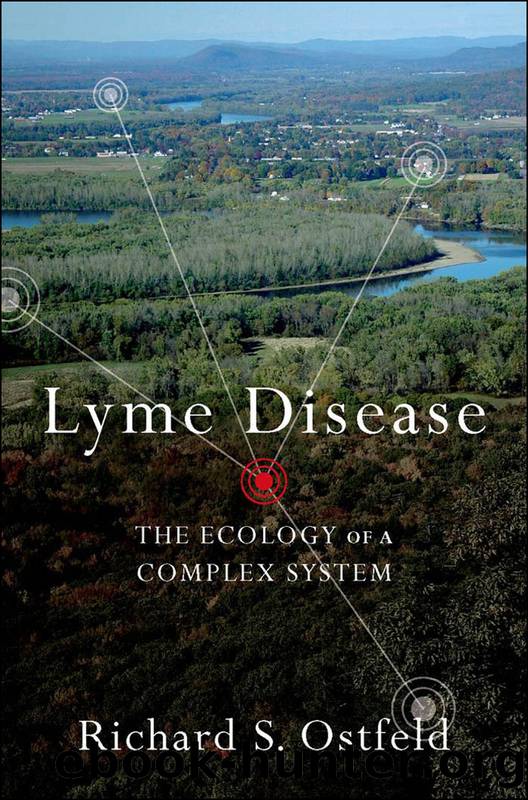Lyme Disease by Richard Ostfeld;

Author:Richard Ostfeld; [Ostfeld;, Richard]
Language: eng
Format: epub
ISBN: 9780195388121
Publisher: OxfordUP
Published: 2011-09-15T05:00:00+00:00
8
Embracing Complexity
Biodiversity
IDONâT HAVE MANY HEROES, BUT I COUNT DAVID QUAMMEN AS ONE. Whatâs most heroic to me about Quammen is how he uses his boundless versatility as a self-taught scientist, journalist, and adventurer to teach the public about ecology and evolution. So, needless to say, I was delighted when Quammen wrote to me in 2007 to see if he could visit the field sites where we are studying ecological determinants of Lyme disease risk. He was in the research phase of a book on ecology of emerging infectious diseases, and his field trip destinations included Republic of Congo, Cambodia, Australiaâs Northern Territory, Gabon, Malaysia, Bangladesh, and the wilds of Dutchess County, New York. So for several days Quammen joined my field crew as we live trapped mammals and birds and collected blacklegged ticks in the forest fragments of Poughkeepsie and beyond, braving poison ivy, barberry thorns, and territorial dogs. These forest fragments sit behind school playgrounds, surrounded by strip malls or suburban yards, or adjacent to cornfields or golf courses. Some are tiny woodlots in backyards, and others are more extensive forested parks. Some have dozens of species of mammals and birds, while others have only a small handful. They might be somewhat less exotic and mysterious than Quammenâs other destinations, but theyâre no less dangerous with respect to infectious disease, and theyâre no less subject to ecological forces.
As described in chapter 5, a group of small mammals are most important in producing infected nymphal ticks and increasing human risk of exposure to Lyme disease. Most prominent among these are white-footed mice, which are the most efficient hosts at infecting ticks with Borrelia burgdorferi and the best host for promoting tick survival (all other hosts weâve studied tend to kill more than half the larval ticks that attempt to feed on them, as discussed later in this chapter). Next best at feeding and infecting ticks are eastern chipmunks. Shrews are the third most efficient reservoirs and feed large numbers of larval ticks, although we donât yet know how well shrews promote tick survival. All other hosts that weâve studied are both poor reservoirs for B. burgdorferi and poor hosts for larval blacklegged ticks. Yet blacklegged ticks feed abundantly on essentially every warm-blooded vertebrate that spends time on the forest floor, irrespective of its quality as a host or its probability of infecting the tick with B. burgdorferi. Chapter 5 describes how risk of exposure to Lyme disease is linked to the abundance of mice, chipmunks, and shrews. But it also indicates that these three hosts donât begin to tell the whole story. Because each larval tick takes one and only one blood meal, every tick that bites some other (nonmouse, nonchipmunk, nonshrew) host will therefore not bite a mouse, chipmunk, or shrew. Our studies of Lyme disease, together with ecological theory, were telling us that our ability to predict the abundance and infection prevalence of nymphal ticks requires understanding the entire community of host species available to the tick populationâthat is, vertebrate biodiversity.
Download
This site does not store any files on its server. We only index and link to content provided by other sites. Please contact the content providers to delete copyright contents if any and email us, we'll remove relevant links or contents immediately.
Application of a Novel Technique for Clinical Evaluation of Nitric Oxide-Induced Free Radical Reactions in ICU Patients by Unknown(683)
Rosenâs Emergency Medicine Concepts and Clinical Practice by Ron Walls; Robert Hockberger; Marianne Gausche-Hill; Timothy B. Erickson; Susan R. Wilcox(560)
Oxidative damage to surfactant protein D in pulmonary diseases by Vitality Starosta1 & Matthias Griese1†(387)
Social Science Perspectives on Global Public Health by Vincent La Placa & Julia Morgan(364)
Constructing Canine Consent; Conceptualising and Adopting a Consent-focused Relationship with Dogs by ERIN JONES(318)
Organic Chemistry: An Acid - Base Approach by MICHAEL SMITH(291)
ADVANCED EMERGENCY CARE AND TRANSPORTATION OF THE SICK AND INJURED by Unknown(255)
Saunders Nursing Drug Handbook 2024 - E-Book by Unknown(252)
Human Microanatomy; Cell Tissue and Organ Histology with Celebrity Medical Histories by Stephen A. Stricker(236)
Socio-Life Science and the COVID-19 Outbreak : Public Health and Public Policy by Makoto Yano; Fumihiko Matsuda; Anavaj Sakuntabhai; Shigeru Hirota(236)
Davis's Comprehensive Manual of Laboratory and Diagnostic Tests with Nursing Implications by Unknown(233)
Berne and Levy Physiology E-Book by Unknown(225)
Diagnostic and Statistical Manual of Mental Disorders, Fifth Edition, Text Revision (DSM-5-TR(tm)) by Unknown(223)
Handbook of Skin Disease Management by Jiyad Zainab;Flohr Carsten; & Carsten Flohr(219)
Replacing the Dead by Mie Nakachi;(219)
The Pocket Guide to Sensorimotor Psychotherapy in Context (Norton Series on Interpersonal Neurobiology) by Pat Ogden(207)
Deep Learning and Medical Applications by Unknown(207)
Themes and Stories in Youthwork Practice by Mark Krueger(196)
Mosby's 2024 Nursing Drug Reference (Skidmore Nursing Drug Reference) (by Team-IRA) by Linda Skidmore-Roth RN MSN NP(193)
